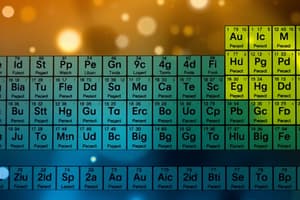Podcast
Questions and Answers
Which is the electronic configuration for oxygen?
Which is the electronic configuration for oxygen?
- 1s2 2s2 2p4 (correct)
- 1s2 2s2 2p6
- 1s2 2s2 2p1
- 1s2 2s2 2p3
In which block of the periodic table is uranium (U) found?
In which block of the periodic table is uranium (U) found?
- s block
- p block
- f block (correct)
- d block
Which is the noble gas notation for chlorine?
Which is the noble gas notation for chlorine?
- [Ne] 4s2 4p5
- [Ne] 3p2 3p5
- [Ne] 3s2 3p3
- [Ne] 3s2 3p5 (correct)
It is easier to determine the electron configurations for the p-block elements in periods 1, 2, and 3 because:
It is easier to determine the electron configurations for the p-block elements in periods 1, 2, and 3 because:
What is the number of valence electrons in cadmium (Cd)?
What is the number of valence electrons in cadmium (Cd)?
Which of these elements has an electron configuration of [Kr]5s2?
Which of these elements has an electron configuration of [Kr]5s2?
Which is the noble-gas notation for lead (Pb)?
Which is the noble-gas notation for lead (Pb)?
In which block of the periodic table is chromium (Cr) found?
In which block of the periodic table is chromium (Cr) found?
Which is the electron configuration for nobelium (No)?
Which is the electron configuration for nobelium (No)?
Arsenic does not have any valence electrons in the 3d orbital because:
Arsenic does not have any valence electrons in the 3d orbital because:
How many valence electrons does lithium (Li) have available for bonding?
How many valence electrons does lithium (Li) have available for bonding?
Which of the following elements has the fewest valence electrons?
Which of the following elements has the fewest valence electrons?
The noble-gas notation for tin (Sn) will contain the symbol:
The noble-gas notation for tin (Sn) will contain the symbol:
The electron configuration of nitrogen (N) is:
The electron configuration of nitrogen (N) is:
Hydrogen reacts with an element to form a compound. Which element would have the most electrons available to react with hydrogen?
Hydrogen reacts with an element to form a compound. Which element would have the most electrons available to react with hydrogen?
Flashcards are hidden until you start studying
Study Notes
Electron Configuration
- Oxygen's electron configuration is 1s² 2s² 2p⁴.
- Strontium has the electron configuration [Kr]5s².
- Nobelium's electron configuration is represented as [Rn]7s² 5f¹⁴.
- Nitrogen's electron configuration is 1s² 2s² 2p³.
Periodic Table Blocks
- Uranium (U) is found in the f block of the periodic table.
- Chromium (Cr) is located in the d block.
Noble Gas Notation
- Chlorine is denoted by noble gas notation as [Ne] 3s² 3p⁵.
- Lead (Pb) has the noble gas notation [Xe] 6s² 4f¹⁴ 5d¹⁶p².
- Tin (Sn) is represented with noble gas notation containing [Kr].
Valence Electrons
- Cadmium (Cd) has 2 valence electrons.
- Arsenic does not have valence electrons in the 3d orbital because its 3d orbital is completely filled.
- Lithium (Li) has 1 valence electron, making it suitable for bonding.
- Among beryllium, boron, carbon, and lithium, lithium has the fewest valence electrons.
Key Observations on Electron Configurations
- Determining electron configurations for p-block elements in the first three periods is easier due to their electrons being assigned to s and p orbitals only.
- Chlorine reacts with hydrogen as it has the most electrons available for bonding compared to oxygen, neon, and nitrogen.
Studying That Suits You
Use AI to generate personalized quizzes and flashcards to suit your learning preferences.




